

 | |||
|
In early spring, with the summer melt still weeks away, researchers flock like migrating birds to the Greenland Ice Sheet. The low, circling Sun reflects off the surface, making the vast ice sheet look like a gently rolling ocean with rippling waves riding over undulating swells that glide off to the horizon. Waleed Abdalati, head of NASA Goddard Space Flight Center’s Cryospheric Sciences Branch, was one of those migrating researchers. His boots were on the ice most years from 1993 through 2004. He slept on the floating tongue of Petermann Glacier (80°N) as the ice groaned and cracked with the rise and fall of the tide. He slept at high elevations of the ice sheet interior where the bitter cold made his lungs ache with each breath. He slept on the western flank of the great ice sheet near a large melting area, where a relentless, subfreezing wind rattled his tent constantly. |
|||
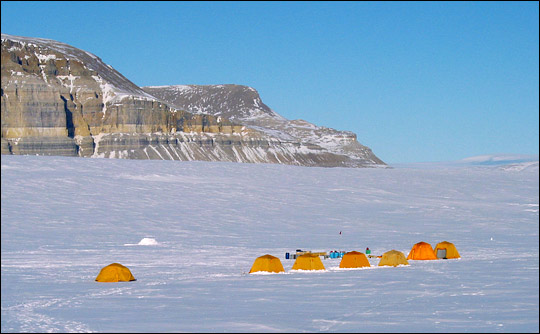 | |||
Abdalati describes life on the Greenland ice sheet as an environment of contrasts. “When the Sun’s position is just right, the scenery is stunningly beautiful,” he says. “At other times, the same scene can seem stark and lifeless.” And while the days can sometimes be a comfortable 32°F (0°C), at other times the brutal cold can be deadly, with a wind chill sometimes reaching below -50°F (-46°C). But it is the wind Abdalati recalls first and most. It’s the endless wind rolling downhill from the frozen highlands toward the distant ocean that becomes your bitter enemy as you trespass across the alien world of the ice sheet. The wind is almost always with you on the ice sheet and, when the temperature is well below freezing, it brings a stinging sensation to any exposed skin and rips away what frail body heat you create. |
Waleed Abdalati and other researchers visited the Petermann Glacier on the northern coast of Greenland every spring. The glacier is beautiful, but remote, cold, and windy. The time spent on the ice and the area that the team could survey were limited by the hostile conditions. [NASA photograph courtesy Waleed Abdalati, Goddard Space Flight Center (GSFC).] | ||
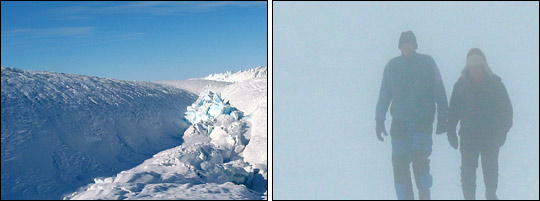 | |||
On-the-ice research in Greenland is generally limited to the short period after the worst of winter’s cold and before summer’s melt can make the ice treacherous. According to Abdalati, an ominous sound mingling with the wind ushers in each summer: gurgling water. Melt water begins to flow under the snow that blankets the ice, enlarging small cracks and fissures under the frozen skin, sometimes trickling and sometimes plunging toward the bottom of the ice sheet. For the first few weeks, the melt water sounds like a peaceful stream. Soon it takes on the menacing roar of a rushing river. |
During warm, clear days researchers on the ice sheet could enjoy the beauty of Greenland’s ice formations. However, in bad weather the cold and high winds made research impossible. (NASA photographs courtesy Waleed Abdalati, GSFC.) | ||
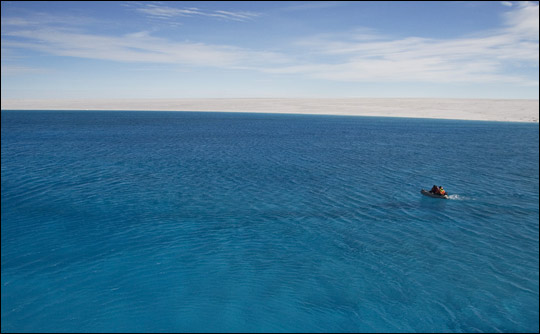 | |||
Even during these “ideal” spring months, the ice sheet is not exactly hospitable. Heavy boots, multiple layers of clothing, and thick mittens make movement awkward. Even the simplest of tasks requires thought, planning, and considerable effort. Still, Abdalati jammed as much research as time and technology allowed into those precious few months each year to chip away at the secrets of the ice. The environment was challenging, but the data were crucial. He hoped he would find answers before it was too late. In the early 1990s, as the Arctic began to warm noticeably, many eyes turned to Greenland. Scientists and policy makers asked: Is Greenland melting? If so, how fast, and how high will sea level rise as a result? “Through the 1990s, the only answer scientists could give was ‘We don’t know,’” Abdalati recalls. |
As the surface of the ice sheet melts, rivers of water flow on the surface, eventually collecting in huge blue pools atop the ice or plunging into deep crevasses. (Photograph ©2005 Greenpeace/Andrew Davies.) | ||
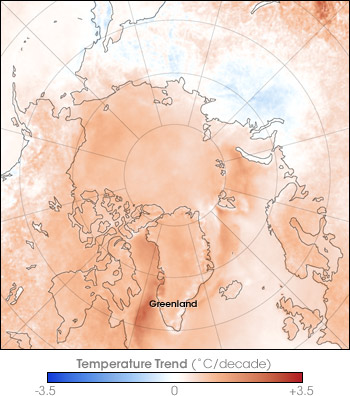
What would large-scale ice loss on Greenland mean to the rest of the world? “Things we’ve come to count on could change,” he explains. Coastlines will recede as sea level rises and ocean water edges inland, threatening coastal cities. The changing ice could impact ocean and atmospheric circulation patterns and the global climate to which life today has adapted. What will be the nature and impact of these changes? Abdalati’s answer: “While the future impacts of the changing ice cover are uncertain, the potential effects are scary enough so that we better figure it out.” [See sidebar: Why Does the Greenland Ice Sheet Matter?] |
Few places on Earth are warming faster than the Arctic. Temperatures have been rising several degrees Celsius per decade (red areas) since 1981. Among the most fundamental questions about Arctic climate change is how the warming will affect the Greenland Ice Sheet. (NASA Map by Robert Simmon, based on data from Josefino Comiso, GSFC.) | ||
 |
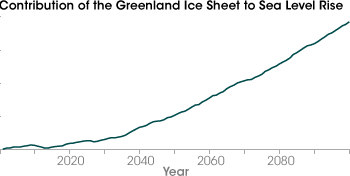
These uncertain, potentially dramatic effects of ice loss are what motivated Abdalati to face so many frigid springs on the Greenland Ice Sheet. Ultimately, he sought to answer the fundamental question—overall, is the Greenland Ice Sheet growing or shrinking? Computer models predicted that as Earth’s temperature rose, the ice sheet would thin and retreat around its margin. Yet, counter-intuitively, the models also predicted that the warmer temperatures would cause snowfall to increase in Greenland’s highland interior so that the ice sheet would actually grow thicker there. Several field studies confirmed these predictions. Bill Krabill, a geoscientist at NASA’s Wallops Flight Facility, measured an inland gain of up to 1 meter of snow and up to three times average snowfall in some areas of Southeast Greenland between 2002 and 2003. In 2005, Ola Johannessen, from the University of Bergen’s Nansen Environmental and Remote Sensing Center, measured a gain of 2.4 inches per year from 1992 to 2003 for elevations above 1,500 meters, with a net ice loss below that elevation. But even if the models were right, which trend—ice gain in the interior, or melting at the margin—would prove greater, and by how much? |
The Greenland Ice Sheet could contribute around 4 centimeters to sea level rise by the year 2100, about 10 percent of the total predicted rise. This estimate could be too low, however, since it does not account for rapid, large-scale ice loss through processes such as the accelerated flow of glaciers into the sea. (Graph by Robert Simmon, based on data from Johannes Oerlemans, Universiteit Utrecht.) | |